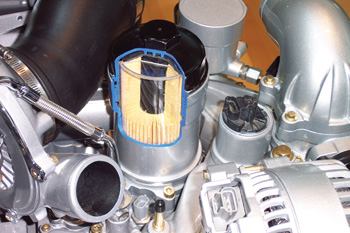To many people, oil filters are a generic product. They look for the cheapest filter that fits their vehicle and make their buying decision based on price alone. Oil filters do look pretty much the same on the outside, but what’s inside the can or cartridge can make a big difference.
 Filter manufacturers use a variety of different filter media to keep the oil clean. Resin impregnated paper filter media has been around forever and uses cellulose fibers to trap contaminants. A high-quality paper filter element with evenly spaced pleating can provide good filtering efficiency. The typical OEM or standard replacement oil filter with cellulose fiber media will trap about 97.5 percent of most particles that are 15 to 40 microns in size or larger.
Filter manufacturers use a variety of different filter media to keep the oil clean. Resin impregnated paper filter media has been around forever and uses cellulose fibers to trap contaminants. A high-quality paper filter element with evenly spaced pleating can provide good filtering efficiency. The typical OEM or standard replacement oil filter with cellulose fiber media will trap about 97.5 percent of most particles that are 15 to 40 microns in size or larger.
Some filters use a combination of cellulose fibers and non-woven plastic or synthetic fibers to improve filtering efficiency. The different materials may be combined together or used in a multi-layer filter element. These types of filters can have filtering efficiencies as high as 99.5 percent and trap up to 40 percent more contaminants with particle sizes as small as 3 to 5 microns. Non-woven synthetic fleece fibers also are used in some filters to increase filtering efficiency and capacity.
One of the biggest challenges that all oil filters have to cope with today is longer service life. Though 3,000-mile oil changes are still recommended for severe service driving, OEM-recommended oil change intervals for “normal” driving today can range from 5,000 to 7,500 miles, or up to 10,000 miles or more. Many vehicles don’t even have a recommended service interval and rely instead on a “Service Reminder Light” to estimate when the oil needs to be changed. On some vehicles, the light may not come on for 12,000 to 15,000 miles depending on driving conditions! That’s a long time for an oil filter to remain in service.
According to some sources, some of the cheapest no-name generic oil filters from China are not even lasting 3,000 miles before they plug up and go into bypass mode. All oil filters have a bypass valve that is designed to open if the filter becomes clogged. The bypass valve prevents a dangerous loss of oil pressure in such situations, but also allows dirty unfiltered oil to circulate through the engine. It’s the same as running with no oil filter at all!
Worse yet, if the filter media breaks apart or fails, chunks of debris can enter oil passages and cause all kinds of problems inside the engine. Such debris debris can restrict or block critical oil passages causing a loss of oil pressure or engine damage.
The best advice you can give your filter customers is to buy the best oil filter that is listed for their engine — especially if they are not changing their oil for 7,500 miles or more. Many premium filters can go 10,000 miles or more. In any event, extended oil service intervals of 10,000 miles or more require both synthetic motor oil and a premium quality filter.











